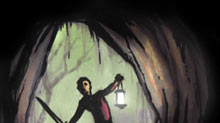by Demian Katz
 The Penguin Ultimatum
The Penguin Ultimatum
Published by Eight Foot Llama
Designed by Jim Doherty
Illustrated by Scott Starkey (cards) and Rick Chamberlain (box)
110 cards, 12 invitation markers, 8 scoring stones, 1 color rules sheet
2-4 players
$19.95
The Penguin Ultimatum has to be one of the best game titles I've come
across in a while. Although penguins, like cows (and, to a lesser
degree, aardvarks), are overused as a source of instant mirth, the idea
of penguins presenting an ultimatum is itself inherently humorous. The
problem, though, is that the game, despite being a competent design,
doesn't quite live up to its wonderful name. The premise of The Penguin
Ultimatum is that the penguins have presented an ultimatum to their
emperor: he must throw them a good party, or else they will, well,
continue to be bored. The players take on the roles of penguin jesters,
and are placed in charge of arranging the entertainment. The problem
here, of course, is that the ultimatum is not actually part of the game
play; and a more appropriate title would be something like "Penguin Party," which
unfortunately just isn't as funny. I can see why the funnier title was
chosen, but it leads to a little disappointment - the laughter pretty much stops
after you open the box.
Based on the title, I was expecting the game to be similar in flavor to
the average Cheapass offering; however Penguin is actually more like a
German design. The game could actually be completely abstract, as the
theme exists only to add flavor. The Penguin Ultimatum is a strategic
card-laying game designed for 2-4 players comprised of:
- 110 cards
- 12 invitation markers
- 8 scoring stones
- 1 color rules sheet
Play takes place on the iceberg on which penguins are partying,
otherwise known as the table, and as play proceeds, cards representing
both entertainers and penguin partygoers are placed on the iceberg.
The entertainers belong to several different species, including sheep,
kangaroos, seals and bears who perform a variety of acts: juggling, acrobatics, dancing and music.
At the start of play, three or four entertainers (depending on the
number of players) are placed on the table to get things started.
Players each begin with ten points, three "invitation markers," a hand
of four penguin cards and an activity card that matches one of the four
types of act. At the start of each turn, the current player first puts
down a penguin card adjacent to any other card on the iceberg. Several
factors affect the strategy of this action. First of all, penguin cards
come in several different colors, and penguins do not like to party next
to birds of the same color; if two cards of the same color are ever
placed next to each other, a "mingling fee" must be paid from the
player's current score. A penguin's color also determines what type of
animal the penguin finds amusing; additionally, each penguin card is
most amused by a particular type of act. Logically enough, it is
desirable to place penguins next to acts that will amuse them. Once the
card is placed, the player may place or move one of their "invitation
markers" onto any penguin card in play that does not already have a
marker on it. Players only score points for penguins that currently have
invitation markers on them, so it obviously makes sense to put markers
on penguins that are soon to be amused.
After a player has played a card and invitation marker, there is the
possibility that an entertainer will perform. Each entertainer card has
several dots on it. Whenever there is another card adjacent to every dot
on the entertainer card, the act begins. Some penguins will be amused by
the act, and any player who has an invitation marker on an amused
penguin will score points equal to the number on the penguin's card.
After points have been handed out, the player who scored the fewest
points gets to take the entertainer card. The card is then replaced on
the iceberg with a closed curtain card, and the current player gets to
put another entertainer down elsewhere on the iceberg. Entertainer cards
are worth collecting for two reasons: they can be cashed in to avoid
mingling fees, and certain sets of them can be collected for bonus
points at the end of the game.
The game comes to a close either when the iceberg gets full or when all
of the entertainer cards have been played. Bonus points are handed out
to players who hold the most number of a particular species of
entertainer and to players who hold entertainer cards that match the
activity card they were given at the start of play. At this point,
predictably enough, the person with the most points wins.
Conclusions
While not the most compelling game I've ever played, there is
definitely strategy to this one, and it's fun to play once in a
while. It gets bonus points for a high-quality presentation with nice
glossy cards, cute illustrations, and the sets of attractive wood
and glass pieces. Yet it also loses points for failing to capture
the humor implied by its name. A stronger theme would almost certainly
have increased replay value and might also have elevated this from being
a solid-but-unremarkable card game up to being a minor classic.
It seems strange to criticize a game for being good but not quite good
enough, but that's the bottom line for The Penguin
Ultimatum. Without funny gameplay, a funny name just isn't enough.
| Related reviews on OgreCave: |
|
|




